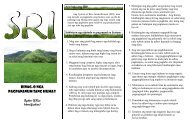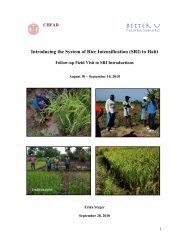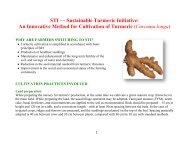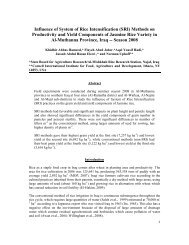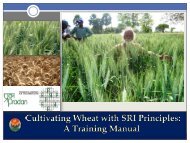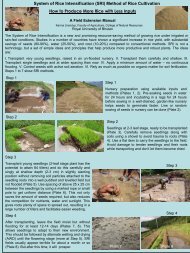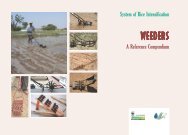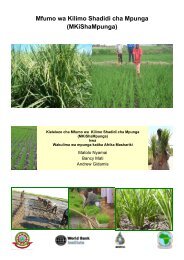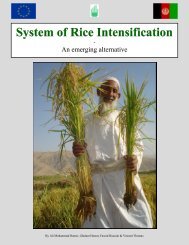EFFECT OF THE SYSTEM OF RICE INTENSIFICATION (SRI) ON ...
EFFECT OF THE SYSTEM OF RICE INTENSIFICATION (SRI) ON ...
EFFECT OF THE SYSTEM OF RICE INTENSIFICATION (SRI) ON ...
Create successful ePaper yourself
Turn your PDF publications into a flip-book with our unique Google optimized e-Paper software.
chemical fertilizers. It is part of the ILFARM project to inspire farmers to use more composts for<br />
those who use chemical fertilizers and thus reducing the chemical fertiliser consumption (CEDAC,<br />
2008c) and farmers do perhaps therefore not dare to say that they still use some chemical fertilizers<br />
as they have an interest in receiving extension services from CEDAC.<br />
Given that the sample size for this report was 30 households and the baseline study involved 451<br />
households (CEDAC, 2008a) the large reduction in chemical fertilizer use identified in the present<br />
study might have resulted from a skewed picture due to the sample size.<br />
The access and amount of biomass might pose problems upon extending <strong>SRI</strong> to larger areas.<br />
Dobermann (2004) states that a major constraint with <strong>SRI</strong> is the labour input needed to transport<br />
and apply organic materials to the fields. Bunch (2002) reports that upon a visit in Madagascar <strong>SRI</strong><br />
farmers spent up to l00 labour days collecting organic materials and applying them to their fields. In<br />
the area of Prey Veng access to organic material is scarce as all straw is removed in order to use as<br />
animal fodder. Anthofer (2004) found from <strong>SRI</strong> trials in Cambodia that farmers would conduct <strong>SRI</strong><br />
on the nearest field to the homestead land. This would imply that the load and transport of compost<br />
and organic amendments is reduced. Considering the workload involved in transporting and<br />
producing composts it would indicate that farmers are forced to use many labour hours, and only<br />
larger households can afford to use labour on such a large scale.<br />
The use of GMs might therefore be a solution in order to increase the amount and the access to<br />
organic materials. GMs are however normally not considered to be used traditionally by Cambodian<br />
farmers but is in many cases introduced by organizations (Anthofer, 2004). However most of the<br />
interviewed households had several trees such as e.g. Neem and Sesbania which are common<br />
around homesteads in Cambodia (Author’s own observation, 2008). The ILFARM project plans to<br />
plant 500.000 trees in order to increase the access to GM (NORDECO, 2008). Appendix E provides<br />
information on five main trees already found and which will be planted any time soon.<br />
9.5. <strong>SRI</strong><br />
The sustainability of a farming system can be measured in many ways. The following parameters<br />
were examined: use of seeds, rice varieties grown, <strong>SRI</strong> techniques, yields, present <strong>SRI</strong> field sizes<br />
and future <strong>SRI</strong> field sizes.<br />
51



